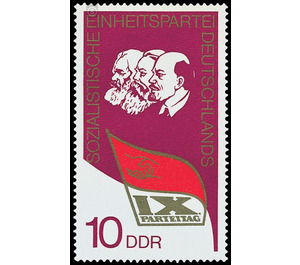Commemorative stamp series - Germany / German Democratic Republic 1976 - 10 Pfennig
Theme: Post & Philately
| Country | Germany / German Democratic Republic |
| Issue Date | 1976 |
| Face Value | 10.00 |
| Color | red |
| Perforation | K 14 |
| Printing Type | Rotogravure 2 |
| Stamp Type | Postage stamp |
| Item Type | Stamp |
| Chronological Issue Number | 1865 |
| Chronological Chapter | GER-DDR |
| SID | 183946 |
| In 28 Wishlists | |
IX. Party Congress of the SED IX. Party Congress of the Socialist Unity Party of Germany, the Ministry of Posts and Telecommunications of the German Democratic Republic issued two multicolored special postage stamps and a special postage stamp block. IX. PARTY DAY OF THE SOCIALIST UNITY PARTY OF GERMANY From 18 to 22 May 1976, the IX. Party Congress of the Socialist Unity Party of Germany meet. The highest forum of the SED will draw the balance of the hitherto most successful stage in the development of the GDR and determine the concrete tasks of the leading social force in our country for the further development of the developed socialist society. The IX. The SED Party Congress will also take stock of the results of one of the broadest and most effective mass movements in our history - the popular debate on the documents available to the party congress. Taking into account all the ideas, suggestions and criticisms, the new SED party program, its revised statute and the five-year plan directive for the years 1976-1980 will be adopted. Especially the popular debate in preparation of the IX. Party Congress of the SED made it clear to what extent the SED has developed as a political leader in the GDR. Hundreds of thousands of members and candidates of the SED, members of the DBD, CDU, LDPD and NDPD as well as non-party workers, men and women of various ages, professions and ideological positions spoke up. For the most part, these contributions have been coupled with the outstanding initiatives of our working people in socialist competition, in the innovator movement, and in other levels of daily exercise of power. All thoughts and hints served one purpose: to create even better conditions for their own work, that in the GDR - in harmony with the development of all socialist countries and firmly established around the Soviet Union - the developed socialist society was erected swiftly and systematically and communism can come a little closer. This issue of special postage stamps also aims to be a discussion bulletin in this debate. It points to three important assets of our development so far - especially in the aftermath of the 8th Party Congress of the SED - whose continuation will continue to form the basis of our successes in the future. The portraits of Karl Marx, Friedrich Engels and Vladimir Ilyich Lenin - together with the emblem of the IX. Party Congress of the SED arranged on a red flag - express that the successes in our development were only possible because the SED has always moved on the ground of Marxism-Leninism. The SED is a Marxist-Leninist party and, as such, always endeavors to creatively apply the experiences of the avant-garde of the revolutionary working-class movement - the CPSU. The red flag of the labor movement symbolizes that the SED, as part of the revolutionary world movement and the socialist community of states, sees itself as its leading force and leads a consistent struggle against all the enemies of the working class, especially against imperialism. The present 10 pfennig value should therefore point to the class character of the SED as a revolutionary vanguard of the working class.


